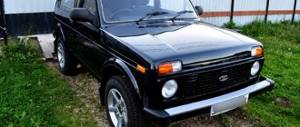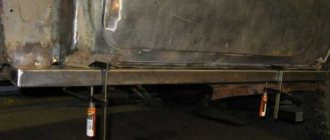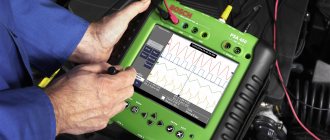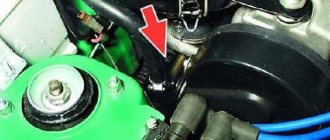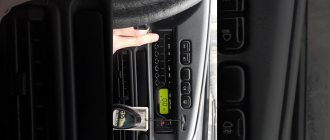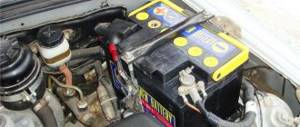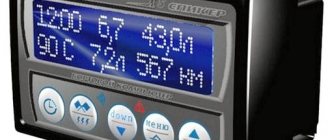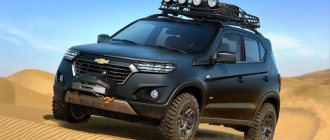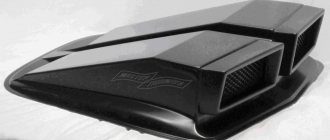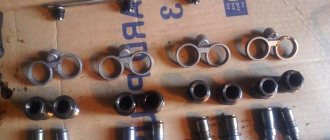The long Niva VAZ-2131 or, as it is now called, LADA 4x4 5D, is just an extended version of the regular short Niva without any significant design changes, with the exception of additional doors. However, the behavior of these two cars is very different both in the city and on the highway, and in off-road conditions. When choosing between a regular LADA 4×4 and a Niva with an extended wheelbase, you need to clearly define the tasks that will be assigned to the car. Let us highlight the main features of the VAZ-2121 and VAZ-2131.
Advantages of a short Niva compared to a VAZ-2131
So, let’s list the obvious advantages of the short-wheelbase Niva:
- permeability;
- maneuverability;
- dynamics;
- body rigidity;
- less consumption;
- less weight.
Appearance of the “old” and updated Niva
All these advantages stem from the short wheelbase and low weight of the LADA 4×4. Now let's look at the long Niva.
Niva is not just a car
"Niva" is not just a car. This is a special philosophy that you first need to comprehend and then learn to live with it
Before the Chevy Niva, I had five classic Nivas, starting with the Soviet-made VAZ-2121. So, believe me, I have something to compare with. There were many things I didn’t like about that first Niva. First of all, there are two doors. It's terribly impractical. Also, sitting with your butt on the floor, when only your head sticks out from behind the steering wheel, making the view from a car with good glazing surprisingly poor (current “nivovods” cannot understand this, since in post-perestroika cars the front seats are installed much higher). Well, and a hydraulic booster, which the Niva never had, and therefore the surprisingly thin steering wheel from the VAZ-2103 could not be turned at all when the car was standing.
Import substitution in a separate edition of the magazine “Club 4x4”
But despite everything, we must admit that overall the Niva is a good car. Only, unfortunately, it broke down too often, and it was inconvenient to drive. Just torture, to be honest. Therefore, at the first opportunity, I exchanged another classic Niva for a foreign car, before the crisis really got to me. And when the moment of choice came, I chose the UAZ. The solution was prompted by the widely publicized import substitution: a true patriot should drive a Patriot. But a call to friends in Ulyanovsk instantly sobered me up. Ulyanovsk residents prefer not to drive the products of their native plant: the latest generation of cars turned out to be too fragile. Or, they say, look for a used one with an Iveco engine, produced in 2006, or better... buy a Chevrolet Niva. A somewhat unexpected proposal, right? I never even thought about this car before.
I like the driver's workplace. I spent many hours driving
Operating the transfer case with one lever is much more convenient than dealing with two on old Nivas.
The air conditioner coped with its task quite well even in hot Astrakhan
As a result of a long search full of vivid adventures, I purchased “Dusya” - a 2006 Chevrolet Niva with almost no mileage. The previous owner drove it twice a year to the country. The car was in an expensive configuration, with audio equipment and air conditioning. Two years of operation and 85,000 kilometers traveled showed that the choice was right. Thanks to Ulyanovsk residents! The car, surprisingly, suited me almost completely. It turned out to fix exactly what was so annoying about the classic Niva: now there is a normal comfortable seating position, front seats with armrests, five doors, full-size rear seats for passengers and, again, power steering. The trunk is small, but it fits everything I usually need, including the compressor and rack jack. In addition, the front wheels of the Shevik turn at a larger angle compared to the classic, which makes the car very maneuverable. Well, in other respects, the Chevy Niva is an ordinary modern car, hardly in any way much inferior to other budget class crossovers.
At the same time, the Chevy Niva has its global pros and cons. The main drawback is the engine, which essentially comes from the third quarter of the twentieth century. Yes, it has modern injection instead of a capricious carburetor, yes, oil does not leak from it like the old Nivas, but still it is not able to accelerate the car normally, as a result of which the car has gained fame as the slowest in its class. True, there is also a positive quality that partially compensates for the annoying lack of power - cross-country ability. The main trump card of the car! Moreover, despite the complete absence of any off-road electronic systems, in this indicator the Chevrolet Niva is on par even with cars from higher classes.
The fourth gear in the box has died for a long time
There is another advantage, which is rarely written about by “auto experts” who have never traveled outside the immediate Moscow region. Why is Shevik so loved, for example, in Chechnya? Yes, because the suspension of this car allows you to fly over broken dirt roads at speeds that are unrealistic for ordinary crossovers. When I tried this for the first time, I even reached under the car to see if it had aftermarket shock absorbers installed. It turned out not. The original suspension has excellent energy capacity and absorbs any bumps at speed, even when driving with a full load. Although, if you think about it, there is nothing surprising here. The long-time predecessor of the Chevy Niva, the classic Niva, was once created precisely as an SUV with a dynamic (that is, swooping) way of overcoming obstacles. If the engine power is not enough to crawl under tension, we will take the obstacle by storm! This is normal for any Niva.
There is enough space in the back to carry three adult passengers of normal height and build.
The weakest point of the car is the towing eyes. They were made by some enemy, because it is impossible to hook a normal shuckle to them
Serving “Dusya” turned out to be easy. It can be repaired in any garage. In my case, the Armenians from the nearest cooperative did an excellent job with the repairs. Branded repairs in Moscow are limited to just a couple of places. On the one hand, the official service is more convenient, because you don’t have to run around looking for spare parts yourself. On the other hand, it is expensive and you will probably be deceived, as, for example, I was at Niva-Center, when I tried to install on Dusya an unnecessary “GM branded muffler” costing 5,000 rubles, which costs no more than 3,500 rubles auto shops. They may impose some unnecessary work or first disassemble the car, and then sharply increase the cost of the work. Therefore, finding a reliable car service center is the most important task. Ideally, it is better to do many things yourself, especially since the Chevrolet Niva is simple and straightforward to maintain.
The car has many components familiar to a “Nivovoda” driver, attention to which significantly reduces the cost of owning a car. For example, with each scheduled maintenance, a mandatory adjustment of the wheel bearings is required, which, in principle, is within the power of any owner. If the wheel bearings become weak and you don’t notice it in time, then first the car will start to steer unintelligibly (the first sign), then it will begin to eat up the rubber, and then the hub itself will run out, which will entail expensive repairs costing about 5,000 rubles. In general, for any driver of a foreign car, the prices for repairing a Chevy will seem like a fairy tale, because they are many times cheaper. For example, a new gearbox will cost 16,000–17,000 rubles. Its weak point is the gear blocks, as a result of wear of which the fifth or fourth speed begins to be knocked out. The box is not difficult to repair, but you need to carefully look for someone who can do it properly. In Moscow there is a service (search on the Internet) for replacing your gearbox with an already repaired one. Cheap, cheerful and even give a guarantee.
The main advantage over foreign cars is the off-road suspension and transmission
In two years I had to replace two expansion tanks - they cracked and began to leak
The trunk lining and the fifth door suffer the most from corrosion.
Chevy Nivs are very fond of bursting expansion tanks. At Dus, I had to change three things in two years. But they cost pennies, and the replacement operation is also simple. The car simply “eats” the front lights. They often burn out the next day after replacement. Therefore, many “nivovods” simply stop paying attention to the non-functioning size.
In my car, after about 75,000 km, the right hub fell apart. Replacement cost about 5,000 rubles. From the very beginning the clutch release bearing creaked. The creaking continued for about 55,000 km, after which it somehow suddenly turned into a squealing, and then a heart-rending squeal. Around the same time, fourth gear began to slip out (even when I was holding the lever with my hand). The job of replacing the clutch cost 5,000 rubles, and a branded set of spare parts cost the same, a total of 10,000. I didn’t change the gearbox - I’m waiting for it to completely fall apart so that I can then install a tuning one, with shortened gear ratios. This box allows you to accelerate a little faster, but forces you to use the lever and press the clutch pedal more often.
I only charged the air conditioner once, when I first bought the car. So far it works without any complaints.
The transfer case howls, and exactly the same as on the classics. Of course, maybe I was unlucky with a particular specimen, but the peak of howling occurs approximately in the range of 60–80 km/h. However, you get used to it over time.
First of all, I tuned the car a little by installing a Krasikov automatic differential (DAK) in the rear axle. At one time, we in the editorial office tested this type of blocking, and I really liked how it worked. The decision turned out to be correct. On asphalt and in the city, DAK does not manifest itself in any way, but off-road it works as a one hundred percent lock of the rear axle, independently activating at the moment of slipping. The driver does not need to do anything. It sounds like an advertisement, but, alas, the DAK people won’t pay me a penny for this. Be that as it may, the fact remains: DAK, priced at 14,000 rubles, with installation costing about 4,000, perfectly replaces expensive electronic lock simulators. In two years of work, including trips on various off-road conditions, the car got stuck only once. Although for this case I have a portable winch, which is either stored in the garage or transported in the trunk (I have never needed it yet), wheel bracelets and a rack jack (I have never had to use it once). To be fair, it should be said that the original tires that the car is equipped with at the factory are not suitable for anything at all. It handles the road disgustingly and does not work at all off-road. So replacing it with a studded one in winter and a Toyo AT in summer was completely justified and greatly expanded the capabilities of the car.
Long trips have shown that traveling by car with a small group (no more than two people) and with a small amount of things is quite comfortable. “Dusya” confidently holds 120–130 km/h on the highway, while consuming 10 liters of 92 gasoline per hundred. If you drive in “pensioner” mode, at a speed of 90 km/h, then the consumption drops to 6.5–8 liters and greatly depends on the number of overtakings. Of course, the Chevik really needs a tow bar, because as soon as you need to transport something, you will certainly get a trailer, or you will have to buy another car. It is inconvenient to carry belongings on this car, and there is almost no space for it.
Perhaps I was just lucky, but after 85,000 km nothing else broke. The car was in minor accidents twice – both times the brakes did not work. The rear drums do their job poorly: either they don’t brake at all, or, after service, they brake too well, immediately going into skid. Only the license plate frame was damaged in the accident. The front bumper of the Dusi first demolished the rear of a VW Transporter, and then destroyed the rear bumper of a Ford Focus.
The car's body also compares favorably with the classic Niva. They say that Chevy cars are galvanized at the factory. You can believe this, because the car is almost completely rust-free, unlike the Niva, which blooms after the first winter, and after five years it needs to be welded. The Chevy Niva's trunk door and especially the luggage rack in the door area suffer from corrosion. Otherwise, the body of a ten-year-old car looks almost like new after washing.
In general, the car left very good impressions from daily trips in any weather, over any distance and on any surface, and if I’m going to change it, then first of all I’ll think about the same one, only a new one.
SMALL IMPROVEMENTS
Many components on the Chevy Niva are very similar to those on the Niva, but modified. On the Niva we had to change the CV joint boots every two years; on this car they are still factory. The ball joints were present when purchased and have not worn out over the course of 85,000 km. Silent blocks also do not require replacement. Oil doesn't flow. At all.
Advantages of the five-door VAZ-2131 compared to the three-door Niva
Thanks to the extended base and increased weight, the SUV has the following advantages:
- road stability;
- smooth ride;
- comfort;
- spacious back row, comfortable seating;
- spacious trunk;
- larger tank volume (65 liters instead of 42 liters on the short Niva);
- large load capacity.
Long wheelbase Niva
Disadvantages of cars
The disadvantages of the short Niva follow from the advantages of the long one: poor handling on the highway, low level of comfort, cramped interior, etc. Accordingly, the disadvantages of the VAZ-2131 follow from the advantages of a short-wheelbase SUV: worse cross-country ability, dynamics, maneuverability, higher consumption.
Read more about cross-country ability
The worse cross-country ability of the VAZ-2131 is justified solely by the extended wheelbase and greater (by about 150-200 kg) weight. Those. If we compare the cross-country ability of these two vehicles on dense soils in the absence of high or deep transverse obstacles (ruts, hillocks, ditches), then in terms of cross-country ability the VAZ-2131 will be only slightly inferior to the VAZ-2121. And in cases where additional mass is beneficial, for example on loose snow or shallow mud, the cross-country ability of a long Niva may be even higher than a short one.
Obey the speed limit
Roads in Ukraine are approximately similar to the roads in the Russian Federation in the 90s. One lane there, one back, and so on for 600 kilometers. Along the way, regardless of the time of year, you will encounter: unimaginable landscapes of harvest fields; trucks heavily loaded with various goods; small and not so small towns and villages and most importantly, inspectors of the sovereign traffic police of various modifications.
They can be on duty at stationary and mobile posts. They have an unhealthy addiction to cars with foreign license plates. Since 2009, fines for traffic violations have increased more than 10 times in Ukraine. In this case, violations, and therefore fines, are classified into sections. For example, violating the rules for placing a vehicle on the roadway.
Also interesting: Stages of replacing a radiator on a Chevrolet Niva with air conditioning without removing the panel
This section also includes driving in the left lane with the right lane free. For such a seemingly minor violation, a fine of around 240-350 hryvnia is provided. In general, I recommend that you carefully read specialized road forums and the text of traffic rules before your trip. It has some differences from the Russian version of the rules. It is also recommended to stock up on the helplines of the Ministry of Internal Affairs of the regions through which you will be passing. It would also be a good idea to write down the phone numbers of several motorist clubs and motorist assistance societies. At the same time, there is no traffic police chaos on the roads; a way out of any situation can be found.
